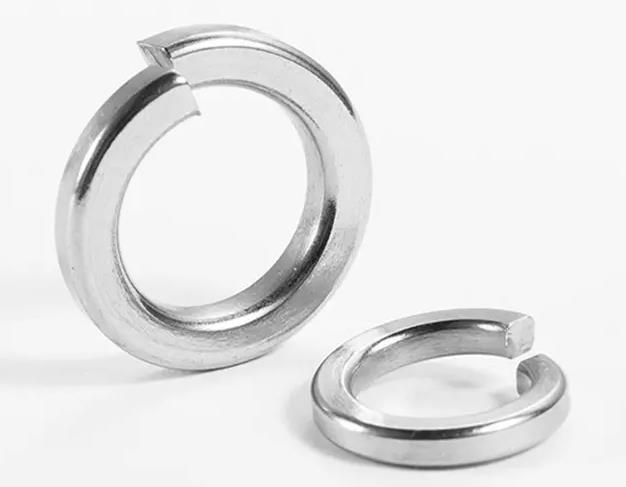Spring washers play a crucial role in mechanical assemblies, primarily by preventing nuts from loosening. Positioned beneath the nut, they find widespread application in both load-bearing and non-load-bearing structures of general mechanical products. What sets spring washers apart is their affordability, ease of installation, and suitability for components subjected to frequent assembly and disassembly.

Key Functions of Spring Washers
The fundamental purpose of a spring washer is to counteract loosening by applying force once screws and bolts are tightened. It accomplishes this by generating friction between the screw or bolt and the material it secures. During vibrations, this friction prevents the screw or bolt from coming loose. In cases where a cotter pin is inserted into the hole of a screw, the slotted hex nut is employed to prevent automatic nut loosening. This configuration is especially useful in situations involving vibration loads or alternating loads.
Another important role of spring washers is their collaboration with three screw and bolt assemblies, often used in conjunction with flat washers.
The Anti-Loosening Mechanism of Spring Washers
Spring washers function based on an anti-loosening principle. When compressed, they produce continuous elastic force, generating friction between the nut and the threaded connection of the bolt. This friction creates torque, which prevents the nut from loosening. Simultaneously, the sharp edge at the opening of the spring washer embeds itself into both the bolt's surface and the connected piece, preventing relative rotation between the bolt and the connected component.

Varieties of Spring Washers
Wave Spring Washers
WG Type and WL Type Wave Washers: These open spring washers can be installed in tight spaces, making them ideal for applying prestress to bearings, reducing bearing noise, and enhancing operational accuracy and stability. They also find extensive use in electronic appliances. Materials commonly used include carbon steel, stainless steel, and copper alloys.
WN Type Wave Washer: This multi-layer wave crest overlapping spring washer is composed of multiple layers of material, designed for situations requiring substantial elastic force and uniform force release throughout the working stroke.
Disc Spring Washer
DIN6796 Disc Spring Washer: Compliant with DIN 6796 standards, this lock washer is used in medium to high-strength bolt and screw connections. It bears significant loads and possesses strong elastic recovery force, capable of withstanding wear, thermal expansion, contraction of wear parts, or seal compression. Disc spring washers can effectively replace ordinary spring washers but are not suitable for use in combination with wedge lock washers and flat washers.
Internal Tooth Spring Washer and External Tooth Spring Washer
These spring washers feature sharp, elastic teeth around their circumference, which press against bearing surfaces to prevent fastener loosening. The internal tooth elastic washer is used beneath screws with small head sizes, while external tooth spring washers are commonly placed under bolt heads and nuts. Toothed spring washers are smaller than conventional spring washers and evenly distribute stress on fasteners, ensuring reliable anti-loosening. However, they are not ideal for parts that require frequent disassembly.

Causes of Spring Washer Breakage
Several factors can contribute to the breakage of spring washers:
Expansion Ring: The spring washer's expansion ring experiences radial outward tension resulting from the axial clamping force generated by tightening torque.
External Chamfer: A nut-bearing surface's external chamfer can generate a radial component from the axial clamping force, causing the spring washer's opening to expand. Smaller chamfer diameters increase the likelihood of expansion ring occurrence.
Flat Washer: Placing a flat washer between the nut and spring washer can help prevent expansion ring formation. However, excessively thin or soft flat washers may not be effective.
Hydrogen Embrittlement: This issue typically arises due to an inadequate heat treatment process and the failure to conduct timely hydrogen removal treatment after zinc electroplating.
Conclusion
This article provides valuable insights into the world of spring washers, encompassing their primary functions, anti-loosening mechanisms, various types, and potential causes of breakage. Armed with this knowledge, individuals can harness the full potential of spring washers in their applications, ensuring optimal performance and reliability.







Comments (0)